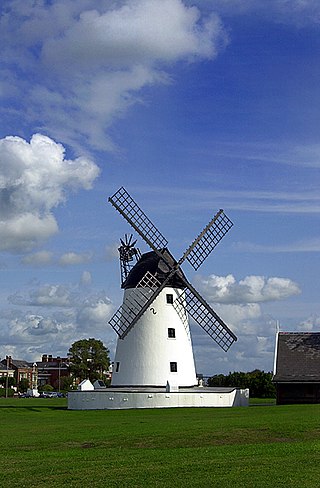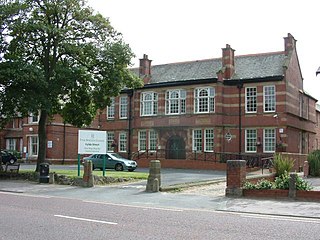
Lancashire is a ceremonial county in North West England. It is bordered by Cumbria to the north, North Yorkshire and West Yorkshire to the east, Greater Manchester and Merseyside to the south, and the Irish Sea to the west. The city of Preston is the largest settlement.

Bolton is a town in Greater Manchester in England. In the foothills of the West Pennine Moors, Bolton is between Manchester, Blackburn, Wigan, Bury and Salford. It is surrounded by several towns and villages that form the wider borough, of which Bolton is the administrative centre. The town is within the historic county boundaries of Lancashire.

Darwen is a market town and civil parish in the Blackburn with Darwen borough in Lancashire, England. The residents of the town are known as "Darreners". The A666 road passes through Darwen towards Blackburn to the north, Bolton to the south and Pendlebury where it joins the A6, about 18 miles (29 km) north-west of Manchester. The population of Darwen stood at 28,046 in the 2011 census. The town comprises four wards and has its own town council.

Lytham St Annes is a seaside town in the Borough of Fylde in Lancashire, England. It is on the Fylde coast, directly south of Blackpool on the Ribble Estuary. The population of the built-up area at the 2021 census was 42,695. The town is made up of the four areas of Lytham, Ansdell, Fairhaven and St Annes-on-the-Sea.

The Borough of Fylde is a local government district with borough status in Lancashire, England. It covers part of the Fylde plain, after which it is named. The council's headquarters are in St Annes. The borough also contains the towns of Kirkham, Lytham and Wesham and surrounding villages and rural areas.

Warton is a village in the civil parish of Bryning-with-Warton, on the Fylde, in the Fylde district, in the county of Lancashire, England.

Lancashire County Council is the upper-tier local authority for the non-metropolitan county of Lancashire, England. The non-metropolitan county of Lancashire is smaller than the ceremonial county, which additionally includes Blackburn with Darwen and Blackpool. The council is based in County Hall, Preston, and consists of 84 councillors.

South Shore is an area of Blackpool, Lancashire, England. It forms the southern part of the town for two miles along the Promenade from Rigby Road to Starr Gate. Its inland boundaries run along Rigby Road, Queen Victoria Road, Ansdell Road, Hawes Side Lane, Common Edge Road and Squires Gate Lane.

The Lancashire County Football Association, also known simply as the Lancashire FA, is the governing body of football within the historical county boundaries of Lancashire, England. They are responsible for the governance and development of football at all levels in the county.

Turton is a historical area in the North West of England. It is part of the ceremonial counties of Lancashire and Greater Manchester. The Turton area is located north of Bolton and south of Blackburn. The area historically formed a township in the ancient parish of Bolton le Moors. The principal village in the township is now known as Chapeltown.

St Anne's Church is an Anglican church in St Annes-on-the-Sea, a town on the Fylde coastal plain in Lancashire, England. It is an active Church of England parish church in the Diocese of Blackburn and the archdeaconry of Lancaster. It is recorded in the National Heritage List for England as a designated Grade II listed building.

St Thomas' Church is an Anglican church in St Anne's-on-the-Sea, a town on the Fylde coastal plain in Lancashire, England. It is an active parish church in the Diocese of Blackburn and the archdeaconry of Lancaster. Designed by Austin and Paley, it is recorded in the National Heritage List for England as a designated Grade II listed building.

St John's Church is in East Beach, Lytham St Annes, Lancashire, England. It is an active Anglican parish church in the deanery of Kirkham, the archdeaconry of Lancaster, and the diocese of Blackburn. The church is recorded in the National Heritage List for England as a designated Grade II* listed building.
St. Anne's on the Sea Land and Building Company was formed in 1874 and played an integral part in the development of the new town of St.Anne's on the Sea from 1875. The company had its roots in the Rossendale area and the most significant investor was William John Porritt, a woollen manufacturer from Helmshore. His money contributed to the building of St Anne's and restored confidence in the project after some early problems.

Lytham Windmill is situated on Lytham Green in the coastal town of Lytham St Annes, Lancashire, England. It is of the type known as a tower mill and was designed for grinding wheat and oats to make flour or bran. Since commercial milling on the site ceased in 1921 the mill has belonged to the town and is operated by Fylde Borough Council, who open it to the public during the summer. The mill also contains a museum run by the Lytham Heritage Trust which explains the history and practice of flour milling.

Lytham library was built originally as a Mechanics Institute. It included a small library of books and a reading room and opened on 30 August 1878. The building was extended in 1898 to celebrate Queen Victoria's Diamond Jubilee, including a new reading room, gymnasium and classrooms. The extension was opened by the Duke of Norfolk. In 1922 the library became part of the Municipal Borough of Lytham St Annes with the amalgamation of St Anne's on the Sea and Lytham Urban District Councils. In 1974 the administration of the library was taken over by Lancashire County Council. In Buildings of England Hartwell and Pevsner describe its 'Dark red and yellow and black brick dressings, including dentil sill bands and 'quoins'. Steep coped gables with jaunty finials, and lancets. Bay windows of yellow brick'.

St Annes's Public Offices is a municipal building in Clifton Drive, St Anne's-on-the-Sea, Lancashire, England. The building, which was the headquarters of St Anne's-on-the-Sea Urban District Council, is Grade II listed.

Lytham St Annes Town Hall is a municipal building on the South Promenade in Lytham St Annes, Lancashire, England. The structure, which is used as the headquarters of Fylde Borough Council, is a locally listed building.






















